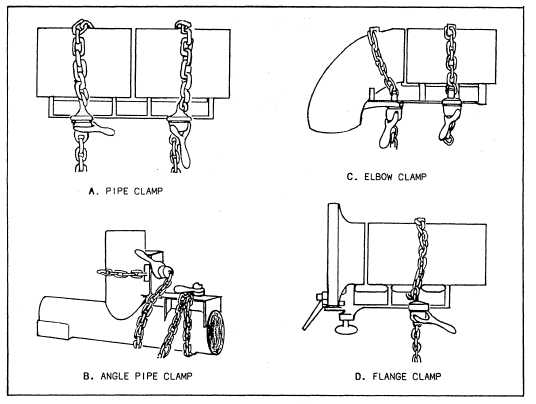
Figure 5-13. - Chain clamps quickly
align pipe fittings of any description. The Linde Company has a method of fusion welding that is remarkably fast and produces welds of high quality. Anyone can use this process for welding pipe if they adhere to the following conditions:
1. Use an excess fuel-gas flame.
2. Use a welding rod containing deoxidizing agents.
3. Use the backhand welding technique.
The following is a brief explanation of the previously mentioned conditions:
1. EXCESS FUEL-GAS FLAME. The base metal surface, as it reaches white heat, absorbs carbon from the excess fuel-gas flame. The absorption of carbon lowers the melting point of steel, thereby the surface melts faster and speeds up the welding action.
2. SPECIAL WELDING ROD. The deoxidizing agents in the recommended rod eliminates the impurities and prevents excess oxidation of carbon. Were it not for this action, considerable carbon, the most valuable strengthening element of steel, would be lost. Thus, even in high-carbon, high-strength pipe, the weld metal is as strong as, or stronger than the pipe material.
3. BACKHAND TECHNIQUE. This technique produces faster melting of the base metal surfaces. Also, a smaller bevel can be used which results in a savings of 20 to 30 percent in welding time, rods, and gases.
One of the most valuable tools you can use when welding pipe is the pipe clamp. Pipe clamps hold the pipe in perfect alignment until tack welds are placed. They are quick opening and you can move or attach a clamp quickly.
Figure 5-13 shows four different types of chain clamps that are used for pipe welding. If these clamps are not available, you can fabricate your own by welding two C-clamps to a piece of heavy angle iron. A piece of 3/8-inch angle iron that is 4 inches by 4 inches by 12 inches is usually suitable. When working with small-diameter pipe, you can lay it in apiece of channel iron to obtain true alignment for butt welding. When the pipe you are working on has a large diameter, you can use a wide flange beam for alignment purposes.
Continue Reading